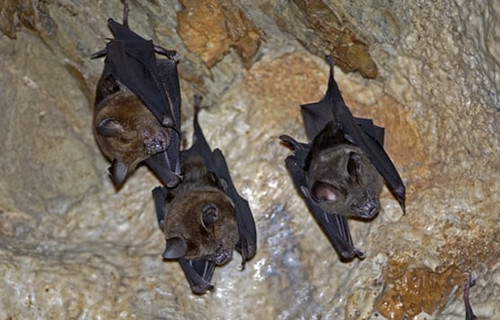15年前,可怕的SARS在全球蔓延,人人恐慌。那么SARS病毒到底源自哪里?武汉的科学家们找到了答案。

Scientists have pinpointed a population of virus-infected bats, which they have linked to the mysterious outbreak of Sars disease 15 years ago. Hundreds died as the virus spread around the globe but its source was never traced.
科学家找到了一个受病毒感染的蝙蝠种群,它们与15年前神秘的SARS(译者注:即我们熟知的非典)疫情暴发有联系。当年病毒蔓延到全球导致数百人死亡,但其源头一直未追踪到。
Now, after years of searching across China, where the disease first emerged, researchers reported a few days ago that they had found a remote cave in Yunnan province, which is home to horseshoe bats that carry a strain of a particular virus known as a coronavirus. This strain has all the genetic building blocks of the type that triggered the global outbreak of Sars in 2002.
如今,在最先出现SARS病例的中国搜寻多年之后,研究人员日前透露,他们在云南省发现了一个偏远的山洞,那里栖息着菊头蝠,其体内携带着一种被称为冠状病毒的特殊病毒毒株,就是这些毒株,含有引发2002年全球疫情的SARS病毒的全部基因片段。
“This will certainly not be the only cave that contains bats infected with these strains of virus, but it is really important that we have found the first one,” said Sars expert Jeremy Farrar, director of the Wellcome Trust. “Samples from these bats will make it much easier to develop a vaccine for the disease and help us be prepared for another outbreak.”
“这肯定不是携带此种病毒毒株的感染蝙蝠栖息的唯一洞穴,但找到这第一个真的很重要,”韦尔科姆基金会的SARS专家杰里米.法勒说,“从这些蝙蝠身上提取的样本将让我们更容易研制出对抗这种疾病的疫苗,有助于我们为应对其再次暴发做好准备。”
Severe acute respiratory syndrome (Sars) first appeared in November 2002 in southern China and spread around the world – often carried by airline travellers – and eventually killed more than 750 people in 37 countries. It was contained by placing patients in quarantine. The outbreak ended in 2004 and the disease has never resurfaced.
2002年11月 ,严重急性呼吸综合征(SARS)最先在中国南方地区出现,后蔓延至世界各地——通常由飞行乘客传播,最终导致37个国家的750人丧生。各国对病人实行隔离,使其得到遏制。疫情在2004年结束后,这种疾病此后没有再出现。
But scientists have always feared that Sars could reappear. Hence the efforts of Chinese scientists – led by Shi Zheng-Li and Cui Jie of the Wuhan Institute of Virology, China – to trace the source of the outbreak. Scientists initially suspected that civet cats, sold in markets in China, were the source of the virus but later turned their attention to bats, which they realised were the prime source of the virus. Civets were merely an intermediary.
但科学家们一直担心SARS卷土重来。因此,以中国科学院武汉病毒研究所石正丽和崔杰为首的中国科学家们千方百计查找疫情的源头。科学家们最初曾怀疑在中国市场上出售的果子狸是病毒来源,但后来把注意力转向蝙蝠,意识到它们才是病毒的主要源头。果子狸仅是传播媒介。
In their study – published in the journal Public Library of Science Pathogens – the Wuhan team reveals that by sequencing the genomes of the different strains of the virus found in horseshoe bats in the cave they found these contained all the genetic pieces that make up the version of Sars virus that caused the 2002 outbreak.
武汉研究团队的论文发表在美国《科学公共图书馆.病原体》杂志上。论文中披露,科学家通过对山洞中菊头蝠体内不同毒株的基因组进行测序,发现这些毒株含有引发2002年疫情的SARS病毒的全部基因片段。
These strains often mix and could have produced a strain that caused the Sars outbreak. “This was a really heroic effort by the team of scientists involved,” said Farrar.
这些病毒毒株往往混合在一起,可能产生了一种导致SARS疫情暴发的毒株。“这真的是相关科学家团队了不起的壮举,”法勒表示。
“Finding these caves and getting sample from bats inside them would have been very hard and dangerous work. However it was definitely worth it. Sars is a horrible disease and extremely dangerous. There is no effective treatment and no vaccine. It was only contained the last time because it was possible to quarantine people while they were still infectious. Now we have a chance to create vaccines and treatments.”
“找到这些洞穴、从洞里面的蝙蝠身上提取样本,那一定是很艰难、很危险的。不过,这绝对是值得的。SARS是一种可怕的疾病,非常危险。它没有有效的治疗办法,也没有疫苗。上一次它能得到遏制,是因为各国可以将具有传染性的人隔离。现在我们有机会开发出疫苗和治疗办法了。”
“In their paper, the Chinese team warn that another deadly outbreak of Sars could emerge at any time. As they point out, the cave where they discovered their strain is only a kilometre from the nearest village. The risk of people becoming infected is a definite possibility, they stress.
“中国的团队在论文中提醒,SARS的新一波致命疫情随时有可能再次暴发。他们指出,被发现的那个洞穴距离最近的村庄只有一公里。他们强调,村民被感染的风险显然是存在的。”
“However, this is good news overall,” saidd Farrar. “We now have something concrete to work on, and I applaud the openness of these Chinese scientists in sharing their work and – I hope – these virus strains.”
“不过,这总的来说是个好消息,”法勒说,“我们现在有了具体的研究对象,我赞赏这些中国科学家公开分享他们的工作成果的做法,并且,我希望,他们也能分享这些病毒毒株。”